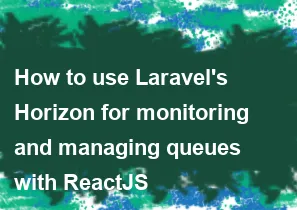How to use Laravel's Horizon for monitoring and managing queues with ReactJS

Laravel Horizon is a powerful tool for monitoring and managing queues in Laravel applications. If you want to integrate Laravel Horizon with ReactJS for a more interactive and dynamic queue management experience, you can follow these steps:
1. Install Laravel Horizon
Ensure you have Laravel installed and then install Horizon:
bashcomposer require laravel/horizon
Publish the Horizon assets and configuration:
bashphp artisan vendor:publish --provider="Laravel\Horizon\HorizonServiceProvider"
2. Configure Laravel Horizon
Configure your Horizon dashboard in the horizon.php configuration file. You can find this file in the config directory.
php// config/horizon.php
return [
// ...
'middleware' => ['web', 'auth'],
'path' => 'horizon',
'domain' => env('HORIZON_DOMAIN', null),
// ...
];
Make sure to add the 'auth' middleware to secure the Horizon dashboard.
3. Install the Laravel Echo and Pusher
Laravel Horizon uses Laravel Echo and Pusher for real-time updates. Install them:
bashcomposer require pusher/pusher-php-server npm install --save laravel-echo pusher-js
4. Configure Broadcasting
Configure broadcasting in your Laravel application. Update your .env file with the necessary broadcasting credentials.
envBROADCAST_DRIVER=pusher PUSHER_APP_ID=your-app-id PUSHER_APP_KEY=your-app-key PUSHER_APP_SECRET=your-app-secret PUSHER_APP_CLUSTER=your-app-cluster
5. Install and Configure ReactJS
Set up your ReactJS environment. You can use Create React App or any other React setup.
6. Create a React Component
Create a React component for the Horizon dashboard. You can use Laravel Echo and Pusher to listen for updates and reflect them in your React component.
jsx// resources/js/components/HorizonDashboard.js
import React, { useState, useEffect } from 'react';
import Echo from 'laravel-echo';
const HorizonDashboard = () => {
const [metrics, setMetrics] = useState([]);
useEffect(() => {
const echo = new Echo({
broadcaster: 'pusher',
key: process.env.MIX_PUSHER_APP_KEY,
cluster: process.env.MIX_PUSHER_APP_CLUSTER,
encrypted: true,
});
echo.channel('horizon')
.listen('HorizonMetricsUpdated', (data) => {
setMetrics(data.metrics);
});
}, []);
return (
<div>
<h1>Horizon Dashboard</h1>
<ul>
{metrics.map(metric => (
<li key={metric.name}>{metric.name}: {metric.value}</li>
))}
</ul>
</div>
);
};
export default HorizonDashboard;
7. Include the React Component
Include the React component in your Blade view:
blade<!-- resources/views/horizon.blade.php --> @extends('layouts.app') @section('content') <div id="horizon-dashboard"></div> <script src="{{ mix('js/app.js') }}"></script> @endsection
8. Run Your Application
Run your Laravel application and the React development server:
bashphp artisan serve npm run watch
Visit http://localhost:8000/horizon to see your Horizon dashboard with real-time updates.
This is a basic example, and you can customize and expand it based on your application's requirements. Make sure to refer to the Laravel Horizon documentation for more advanced configurations and features.
-
Popular Post
- How to optimize for Google's About This Result feature for local businesses
- How to implement multi-language support in an Express.js application
- How to handle and optimize for changes in mobile search behavior
- How to handle CORS in a Node.js application
- How to use Vue.js with a UI framework (e.g., Vuetify, Element UI)
- How to configure Laravel Telescope for monitoring and profiling API requests
- How to create a command-line tool using the Commander.js library in Node.js
- How to implement code splitting in a React.js application
- How to use the AWS SDK for Node.js to interact with various AWS services
- How to use the Node.js Stream API for efficient data processing
- How to implement a cookie parser middleware in Node.js
- How to implement WebSockets for real-time communication in React
-
Latest Post
- How to implement a dynamic form with dynamic field styling based on user input in Next.js
- How to create a custom hook for handling user interactions with the browser's device motion in Next.js
- How to create a custom hook for handling user interactions with the browser's battery status in Next.js
- How to implement a dynamic form with dynamic field visibility based on user input in Next.js
- How to implement a dynamic form with real-time collaboration features in Next.js
- How to create a custom hook for handling user interactions with the browser's media devices in Next.js
- How to use the useSWRInfinite hook for paginating data with a custom loading indicator in Next.js
- How to create a custom hook for handling user interactions with the browser's network status in Next.js
- How to create a custom hook for handling user interactions with the browser's location in Next.js
- How to implement a dynamic form with multi-language support in Next.js
- How to create a custom hook for handling user interactions with the browser's ambient light sensor in Next.js
- How to use the useHover hook for creating interactive image zoom effects in Next.js